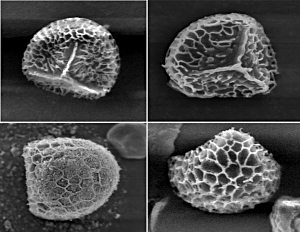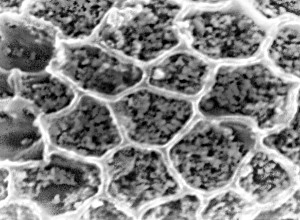|
Fact: The Club Moss spore Lycopodium clavatum is on the tie. |
|
Finding pollen was the original motivation for acquiring sticky tape samples from the tie. It was hoped that finding pollen could generally point to an area in the country where Cooper may have come from. Pine would be local to Washington, cactus would be southwest, corn would be Midwest etc. No pollen diagnostic of a particular area was found, however, one particular species of spore from the Club Moss Lycopodium clavatum was prevalent on the tie. This spore is common today in homeopathic remedies and has been used medicinally for hundreds of years [1]. It is also highly flammable and was used as flash powder up until this century. Methods For both sampling sessions, twelve millimeter aluminum stubs were prepared on site with carbon based adhesive sticky tabs. The protective coating was removed from the stubs and they were immediately pressed sticky side down into strategic places on the tie. (Fig. 2) Once peeled off, they were sealed in special carrier boxes for transport and storage. The stubs from the first 2009 session were removed from the storage boxes and were immediately placed in the vacuum coater and coated with an atomic layer of either gold or palladium. The coating was necessary for clear imaging under the scanning electron microscope (SEM) but had the added benefit of allowing identification of any post-collection contamination since those particles would not be coated. The stubs were scanned visually at powers ranging from 200-2000x. Particles of interest were analyzed for their elemental composition by Energy Dispersive Spectroscopy (EDS). Particular elemental signatures were identified by comparisons to known samples or from the SLICE database that is also used by the FBI. A few spores were found in the 2009 sample sets and these were most similar to the Impatiens family. Impatiens has more than 1,000 species so pictures were sent to Dr. Steven Janssens in Belgium for identification. Dr. Janssens found the closest match to be Impatiens immani from Africa but this was based on limited views of the pollen. Subsequent samples from 2011 clearly showed the trilete aperture (Fig. 1 top row) which is specific to spores and allowed the firm identification of Lycopodium clavatum. Lycopodium in 1971 was used as flash powder by magicians, had a role in the then small field of homeopathy, for skin and stomach maladies, and was used as an anti-sticking agent in pills [1]. Many Lycopodium spores appeared to be covered with an ornamentation of small round particles that are a common feature of the surface texture in Impatiens pollen (Fig. 3). Once their identification as Lycopodium was determined, the ornamentation was out of place, and subsequent Conclusions Microscopic examination of more than 28 SEM stubs from Cooper's tie revealed a quantity of Lycopodium spores. The Lycopodium spores offer the possibility that Cooper was taking some form of pill during working hours while wearing the tie. A retired pharmacist [3] was consulted as to what family of drug might use an orally ingested tablet that would require anti-stick dust, but no information could be found. Medical histories of potential Cooper suspects might reveal a particular drug that could be associated with the Lycopodium additive and thereby forging a link between the suspect and the crime. References 1. National Geographic Desk Reference to Nature's Medicine, R. Johnson, 2006, pg. 110 2. Fine Particles in Medicine and Pharmacy, E. MatijeviÄ, 2012, pg. 45 3. Personal communication: Glen Scanner, retired pharmacist, Sierra Vista, AZ. |


